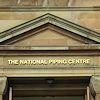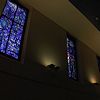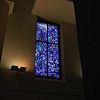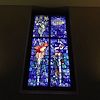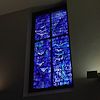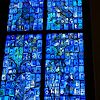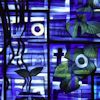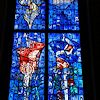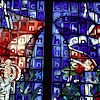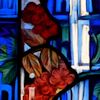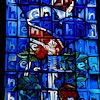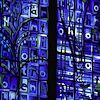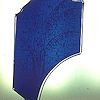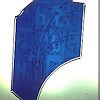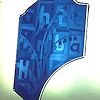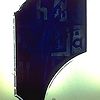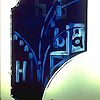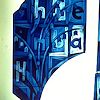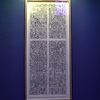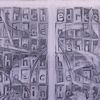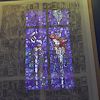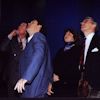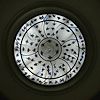WWW.GLASSPAINTER.COM
-ARCHITECTURAL GLASS ARTIST
Piping Centre - Glasgow - Stained Glass Windows
The project for the National Piping Centre was completed in 1996. I am still immensely proud of this project. The lettering throughout these windows is Canntaireachd. This word was unknown to me when I began this project. This is a method of notation basically. It is a sung form of the main tune as vocalisations. Therefore the tune is there. The "words" used show how the notes should be fingered including the grace notes. The windows are based on Pibroch, properly written as Piobaireachd which is the classical form of Scottish Bagpipe music. Basically a theme and variations.
Recently I have returned to the theme of bagpipe music. I have been developing a system whereby each note has a colour. I have been working with this using Bullseye Glass. The project can be seen here.
Piping Centre - Glasgow - The Pibroch Windows
Material - Lamberts Flashed Glass throughout
Technique - extensively etched and painted, some silver staining
Dimensions - 3 windows 2.3Mt x 0.9Mt
Clients - The Piping Trust
Completion - 1996
Architect - Gerry Grams
Explanation Text
Project - The Piping Centre
The Piping Centre has been established in a church which lay derelict in the centre of Glasgow for many years. The windows are located on the first floor and are the three windows above the entrance in this photograph.
This work was commissioned in 1996 by the Founders of the Piping Centre to accentuate their commitment to the classical form of bagpipe music called Pibroch or Piobaireachd also known as Ceòl-Mór which is unique to Scotland. It is based specifically on the oral form called Canntaireachd which was used before the music was written down as a way of preserving and passing on both the melody and fingering of the tunes. It is made up of vocables which have no meaning as words but when sung express the music. There are standardised forms of Canntaireachd one of which is used here but pipers often have their own system.
The intention of these windows is to give an indication of the formal yet poetic nature of Pibroch and to illustrate the complexity and multi-layered quality of this music. The three windows describe three different Pibrochs. The design for the windows is based on a proportional grid. Into this grid is written part of a Canntaireachd starting from the beginning. The windows give only glimpses of forms as in the music only a glimpse of the theme can be attained. The use of the continuous base colour of blue from which the themes seem to materialise and then fade is reminiscent of the melody of the chanter arising from the background sound created by the drones. Below is a detail from each window.
The windows interpret in the imagery used the different types of Pibroch; the Strathspey, Lament and March. Also included are symbols suggested by the titles of the music and elements which have a particular resonance in Scottish history.
Left Window - Pibroch - Glengarry's March
The window contains, in the lower left panel, a reference to a favourite short tune, the “Flowers of the Forest” in this instance represented by bluebells. In other sections there are oak leaves and acorns, alder leaves, apple blossom, leaves and fruits, rowan leaves, flowers and berries, all of which have a special place in Scottish history and folklore. There is also the reflective quality of still water which carries a sense of Lament.
Middle Window - Pibroch - The Battle at Waternish.
This window refers to the military use of the bagpipe. The symbolism of the lower two sections of the window concerns the struggle of the Jacobites against the Union. This is illustrated by; the Jacobite Flag, a claymore and thistles, the first Union Flag, a broadsword and a rose. In the upper sections there is the "fiery cross" which was used as a signal to summon the clans. There is also a reference to the Saltire as a cloud formation seen after a battle. The sunset coloration is relevant both symbolically and historically as the failure of the Jacobite Rebellion marked the end of the period in which the clan system with its direct patronage of pipers. It was during this period that many of the historical Pibrochs were composed. It also marked the beginning of the period during which the playing of the bagpipe and the wearing of tartan was forbidden.
Third Window - Pibroch - The Sound of the Waves Against the Castle at Duntroon.
Based on the above Pibroch, this window alludes also to the relative closeness to water and the sea which one has throughout Scotland.
This work was commissioned in 1996 by the Founders of the Piping Centre to accentuate their commitment to the classical form of bagpipe music called Pibroch or Piobaireachd also known as Ceòl-Mór which is unique to Scotland. It is based specifically on the oral form called Canntaireachd which was used before the music was written down as a way of preserving and passing on both the melody and fingering of the tunes. It is made up of vocables which have no meaning as words but when sung express the music. There are standardised forms of Canntaireachd one of which is used here but pipers often have their own system.
The intention of these windows is to give an indication of the formal yet poetic nature of Pibroch and to illustrate the complexity and multi-layered quality of this music. The three windows describe three different Pibrochs. The design for the windows is based on a proportional grid. Into this grid is written part of a Canntaireachd starting from the beginning. The windows give only glimpses of forms as in the music only a glimpse of the theme can be attained. The use of the continuous base colour of blue from which the themes seem to materialise and then fade is reminiscent of the melody of the chanter arising from the background sound created by the drones. Below is a detail from each window.
The windows interpret in the imagery used the different types of Pibroch; the Strathspey, Lament and March. Also included are symbols suggested by the titles of the music and elements which have a particular resonance in Scottish history.
Left Window - Pibroch - Glengarry's March
The window contains, in the lower left panel, a reference to a favourite short tune, the “Flowers of the Forest” in this instance represented by bluebells. In other sections there are oak leaves and acorns, alder leaves, apple blossom, leaves and fruits, rowan leaves, flowers and berries, all of which have a special place in Scottish history and folklore. There is also the reflective quality of still water which carries a sense of Lament.
Middle Window - Pibroch - The Battle at Waternish.
This window refers to the military use of the bagpipe. The symbolism of the lower two sections of the window concerns the struggle of the Jacobites against the Union. This is illustrated by; the Jacobite Flag, a claymore and thistles, the first Union Flag, a broadsword and a rose. In the upper sections there is the "fiery cross" which was used as a signal to summon the clans. There is also a reference to the Saltire as a cloud formation seen after a battle. The sunset coloration is relevant both symbolically and historically as the failure of the Jacobite Rebellion marked the end of the period in which the clan system with its direct patronage of pipers. It was during this period that many of the historical Pibrochs were composed. It also marked the beginning of the period during which the playing of the bagpipe and the wearing of tartan was forbidden.
Third Window - Pibroch - The Sound of the Waves Against the Castle at Duntroon.
Based on the above Pibroch, this window alludes also to the relative closeness to water and the sea which one has throughout Scotland.




